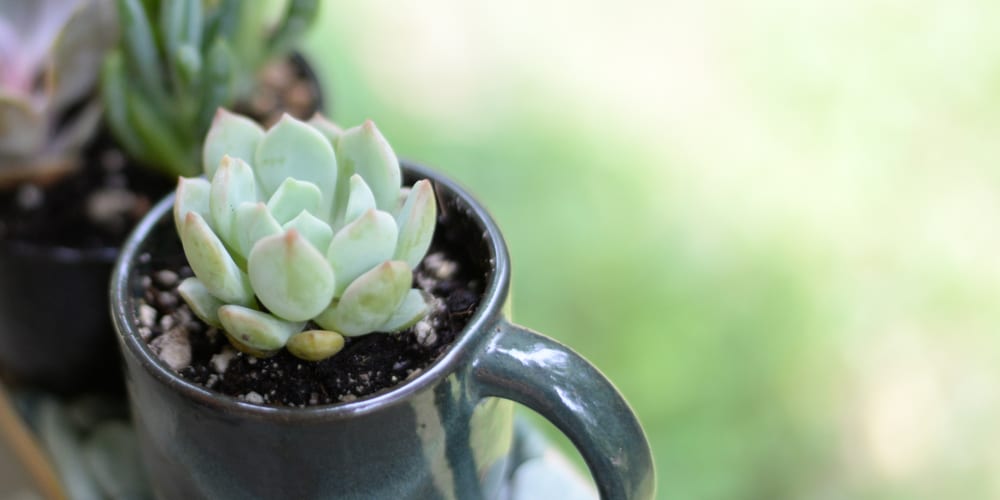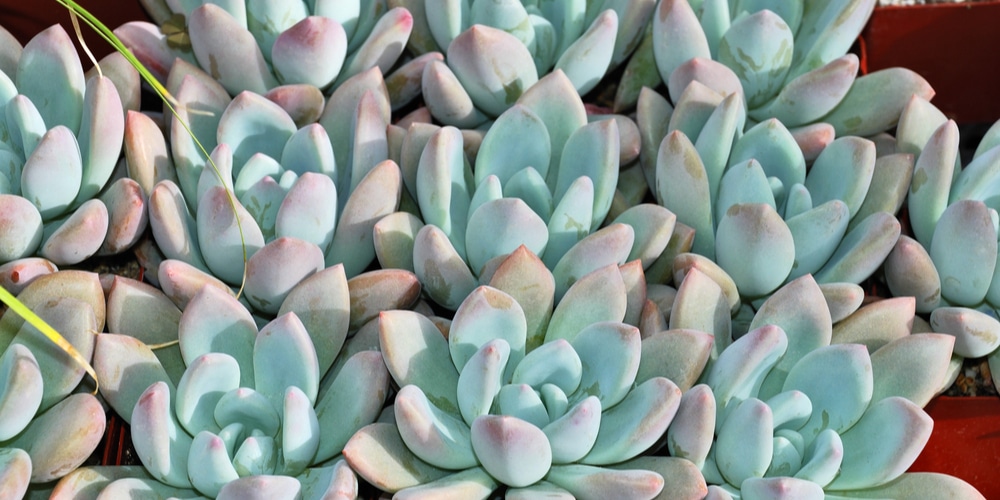Are you looking for a beautiful succulent to add to your collection? Maybe you’re looking for Graptoveria Moonglow, most commonly known as Moonglow. Moonglow is a hybrid succulent known for its beautiful, pale aquamarine-colored, rosette-shaped leaves.
Moonglow is a relatively easy plant to care for. It shows its best features under bright, direct sunlight. When under sunlight, the tip of the leaves will have a beautiful pinkish hue.

| Botanical Name | Graptoveria Moonglow |
| Common Name | Moonglow |
| Plant Type | Perennial |
| Flower Color | Orange – Yellow |
| Size When Mature | 4 inches tall |
| Bloom Time | Early Spring |
| Sun Requirements | Full to Partial Sun |
| USDA Hardiness Zones | 10 – 11 |
| Soil PH Range | 6.0 – 8.0 |
| Soil Type | Acidic, Neutral, Alkaline, Well-draining |
| Water Needs | Low |
| Native Area | Mexico |
What You Need to Know About Graptoveria Moonglow
Graptoveria Moonglow is a hybrid succulent native to Mexico that was created by crossing two other succulents, Graptopetalum and Echeveria. Its leaves have a rosette shape, usually coming in pale aquamarine. The leaves may blend with shades of pink depending on the exposure to sunlight.
Moonglow is a slow-growing succulent that typically only reaches about 4 inches in height and 10 inches in width. It’s an excellent choice for both indoor and outdoor succulent gardens, desktop gardens, or as a potted succulent.
Moonglow also produces flowers in the spring with colors ranging from orange to yellow. The flowers are a nice addition to the plant and contribute to its beauty.
Even though the plant is tolerant to neglect, it is still important to give the proper care it needs.
How to Care for Graptoveria Moonglow
Here’s everything you need to know about growing and caring for a thriving Graptoveria Moonglow:
Light
Give it plenty of bright light to keep your Graptoveria Moonglow healthy and blooming. It will do best in a spot with direct sun for at least part of the day. Placing the plant under direct sunlight will help maintain its beautiful coloration. In addition, if you want your Graptoveria Moonglow to produce flowers, it will need plenty of sunlight.
When indoors, place the plant near a sunny window, south-facing if possible. This will give it the bright light it needs.
Water and Soil Needs
Graptoveria Moonglow is drought tolerant and can store water in its leaves, so it doesn’t need to be watered very often. Allow the soil to be 100% dry between watering sessions. In the cooler months, you can reduce watering frequency.
This succulent also prefers well-drained, sandy soil with plenty of organic matter. A cactus or succulent potting mix would be ideal. If your plant is indoors, make sure to use a pot with drainage holes to prevent root rot.
Outdoors, this plant can tolerate a wide range of soil types as long as it has good drainage. Additionally, putting Moonglow in soil with a ph range of 6.0 -8.0 will make it thrive.
Temperature Requirements
Graptoveria Moonglow is hardy in USDA zones 10-11. Growing Moonglow in a place with a temperature between 30 °F – 50 °F is ideal. These plants are native to hot, arid regions and are well-suited to warm environments. Move the plant indoors if the temperature drops below 30°F to keep it warm and prevent it from dying.
Fertilizer
This lovely succulent is one tough plant that doesn’t need much fertilizer. However, it will benefit from being fertilized with a cactus mix or a succulent fertilizer once a month during the growing season. This succulent is particularly sensitive to chemical fertilizers, so it is important to use an organic fertilizer or one specifically made for succulents.
Common Diseases
One of the most common diseases that affect Moonglow is powdery mildew. The white, powdery spots on the leaves are a sure sign of this disease. Powdery mildew is caused by too much moisture or humidity, and not enough air circulation.
To prevent powdery mildew, plant your Moonglow in well-draining soil and water only when the soil is dry. If powdery mildew does appear, try to increase air circulation around the plant and remove any affected leaves or stems.
Another common disease that affects Moonglow is root rot. Limit your watering and make sure the plant has well-draining soil to prevent this disease. If root rot does occur, cut away any affected roots and replant in fresh, dry soil.
Graptoveria Moonglow Propagation
Propagating Moonglows is easy and only requires a few simple steps. The best time to do so is in the spring when the plant is actively growing. To begin, carefully remove a leaf from the main plant and place it on a surface that is not too hot or cold. Then, using a sharp knife, make a shallow cut in the center of the leaf. Next, apply a small amount of water to the cut area and place the leaf in a well-lit location.
You should see new growth emerging from the cut area within a few weeks. Once the new plant is large enough, you can carefully transplant it into its own pot.
Related Article: Graptoveria Bashful

